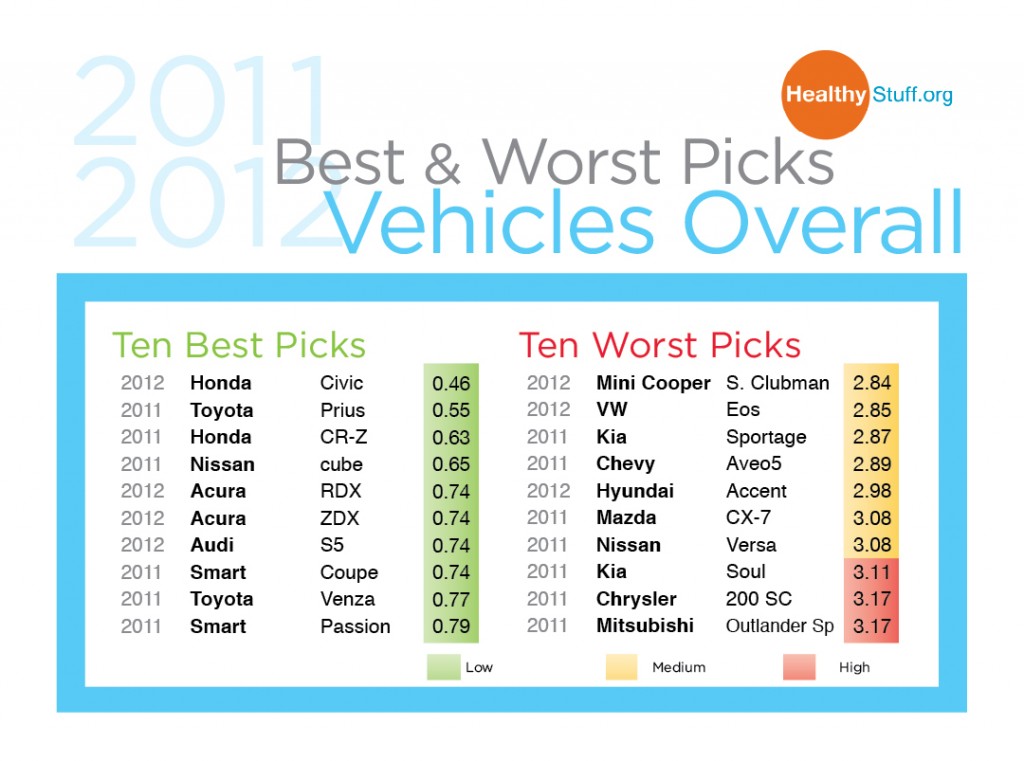Sometimes it’s hard to discern what that funny smell is in your car if you have kids, pets, or both. But the smell I’m most worried about when I get into a car is that “New Car Smell.” Some folks love it because it means your car is bright, shiny and new. Personally, I’m not too keen on it.
HealthyStuff.org just released new data on toxic chemicals in new cars. The “new car smell” is actually the smell of toxic chemicals being released from interior auto parts such as the seating, dashboards and vehicle trim. Since 1960 the amount of plastics used in vehicles has grown 10-fold, rising from 22 pounds in 1960 to over 250 pounds today. Many synthetic materials and plastics are produced with chemical additives, including plasticizers, stabilizers, flame retardants, antimicrobials and antioxidants. Many of these pollutants, including benzene, toluene and xylene, were found in levels exceeding indoor and outdoor air quality standards. Brominated flame retardants (BFRs) in vehicles contribute nearly 30 percent to the average person’s total daily exposure.
HealthyStuff.org released one-of-kind test data on 204 new 2011-2012 model new vehicles. The overall best and worst vehicles are listed below. The 2012 Honda Civic was the overall best rated vehicle and 2011 Mitsubishi Outlander Sport was the worst. The Civic achieved its ranking by being free of brominated flame retardants is all interior components, using PVC-free interior fabrics and interior trim, and containing low levels of heavy metals and other metal allergens. The Mitsubishi Outlander contained bromine and antimony-bases flame retardants in seating, the center console and the seat base, chromium-treated leather on several components and over 400 parts per million lead in seating materials.
HealthyStuff.org has screened 900 vehicles since 2006. Our unique tests show a clear difference between the best vehicles and best companies and, well, the not-so-good ones. The best vehicles today have eliminated important chemical hazards, including hazardous flame retardants and PVC. Today, 17 percent of new vehicles have PVC-free interiors and 60 percent are produced without BFRs in the interiors.
Are you concerned about what chemicals are lurking in your car? Or maybe you’re ready to buy a new car. In any case, check out our results at HealthyStuff.org. Then ask your Senators to support common-sense regulations on chemicals that end up in our cars, homes, and other products. Ask them to support and co-sponsor the Safe Chemicals Act of 2011.



The views and opinions expressed in this post are those of the author(s) and do not necessarily reflect those of MomsRising.org.
MomsRising.org strongly encourages our readers to post comments in response to blog posts. We value diversity of opinions and perspectives. Our goals for this space are to be educational, thought-provoking, and respectful. So we actively moderate comments and we reserve the right to edit or remove comments that undermine these goals. Thanks!